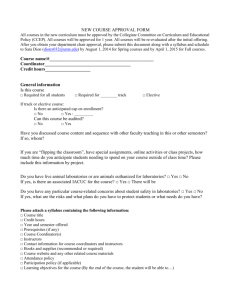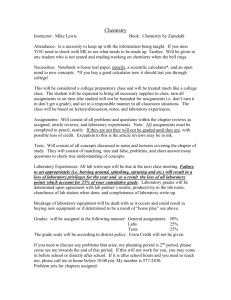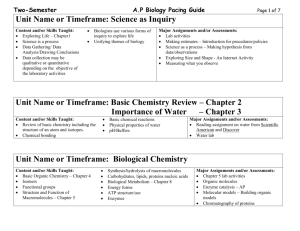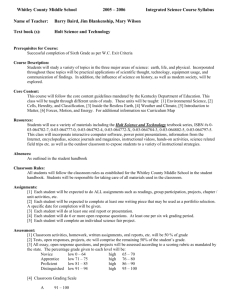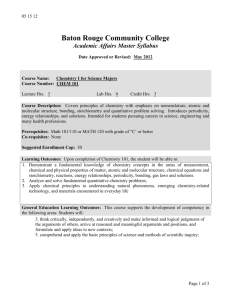AP Chemistry Syllabus
advertisement
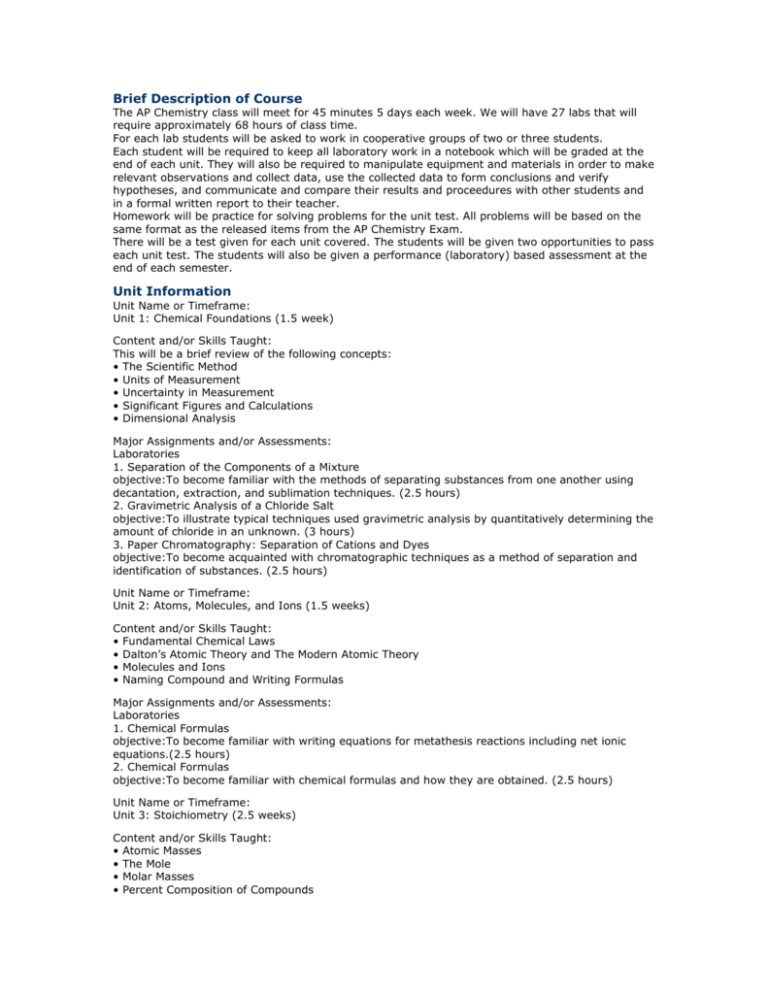
Brief Description of Course The AP Chemistry class will meet for 45 minutes 5 days each week. We will have 27 labs that will require approximately 68 hours of class time. For each lab students will be asked to work in cooperative groups of two or three students. Each student will be required to keep all laboratory work in a notebook which will be graded at the end of each unit. They will also be required to manipulate equipment and materials in order to make relevant observations and collect data, use the collected data to form conclusions and verify hypotheses, and communicate and compare their results and proceedures with other students and in a formal written report to their teacher. Homework will be practice for solving problems for the unit test. All problems will be based on the same format as the released items from the AP Chemistry Exam. There will be a test given for each unit covered. The students will be given two opportunities to pass each unit test. The students will also be given a performance (laboratory) based assessment at the end of each semester. Unit Information Unit Name or Timeframe: Unit 1: Chemical Foundations (1.5 week) Content and/or Skills Taught: This will be a brief review of the following concepts: • The Scientific Method • Units of Measurement • Uncertainty in Measurement • Significant Figures and Calculations • Dimensional Analysis Major Assignments and/or Assessments: Laboratories 1. Separation of the Components of a Mixture objective:To become familiar with the methods of separating substances from one another using decantation, extraction, and sublimation techniques. (2.5 hours) 2. Gravimetric Analysis of a Chloride Salt objective:To illustrate typical techniques used gravimetric analysis by quantitatively determining the amount of chloride in an unknown. (3 hours) 3. Paper Chromatography: Separation of Cations and Dyes objective:To become acquainted with chromatographic techniques as a method of separation and identification of substances. (2.5 hours) Unit Name or Timeframe: Unit 2: Atoms, Molecules, and Ions (1.5 weeks) Content and/or Skills Taught: • Fundamental Chemical Laws • Dalton’s Atomic Theory and The Modern Atomic Theory • Molecules and Ions • Naming Compound and Writing Formulas Major Assignments and/or Assessments: Laboratories 1. Chemical Formulas objective:To become familiar with writing equations for metathesis reactions including net ionic equations.(2.5 hours) 2. Chemical Formulas objective:To become familiar with chemical formulas and how they are obtained. (2.5 hours) Unit Name or Timeframe: Unit 3: Stoichiometry (2.5 weeks) Content and/or Skills Taught: • Atomic Masses • The Mole • Molar Masses • Percent Composition of Compounds • Balancing Chemical Equations • Stoichiometry Calculations Major Assignments and/or Assessments: Laboratories 1. Chemical Reactions of Copper and Percent Yield objective:To gain some familiarity with basic laboratory procedures, some chemistry of a typical transition element, and the concept of percent yield. (2 hours) 2. Stoichiometry and Limiting Reactants objective:To determine the stoichiometric ratio in acid base reactions and then determine which of the reactants will limit the reaction. (2.5 hours) Unit Name or Timeframe: Unit 4: Types of Chemical Reactions and Solution Stoichiometry (2.0 weeks) Content and/or Skills Taught: • Types of reactions • Precipitation Reactions • Stoichiometry of Precipitation Reactions • Acid-Base Reactions • Oxidation-Reduction Reactions Major Assignments and/or Assessments: Laboratories 1. Stoichiometry Of an Iron(III)-Phenol Reaction objective:To determine the stoichiometry of the reaction between iron(III) and the phenol 5sulfosalicylic acid. (2.5 hours) 2. Chemical Reactions objective:To observe some typical chemical reactions, identify some of the products, and summarize the chemical changes in terms of balanced chemical equations. (2.5 hours) Unit Name or Timeframe: Unit 5: Gases (2.5 weeks) Content and/or Skills Taught: • Pressure • The Gas Laws of Boyle, Charles, and Avogadro • The Ideal Gas Law • Gas Stoichiometry • The Kinetic Molecular Theory of Gases • Effusion and Diffusion of Gases • Real Gases Major Assignments and/or Assessments: Laboratories 1. Determination of R: The Gas-Law Constant objective:To gain a feeling for how real gases obey the ideal-gas law and to determine the ideal gas law constant, R. (2.5 hours) 2. Graham’s Law objective:To observe how changes in temperature and pressure affect the volume of a fixed amount of a gas. (2.5 hours) 3. Boyle’s Law objective:To observe how changes in temperature and pressure affect the volume of a fixed amount of a gas. (2.5 hours) 4. Charles’ Law objective:To observe how changes in temperature and pressure affect the volume of a fixed amount of a gas. (2.5 hours) 5. Behavior of Gases: Molar Mass of a Vapor objective:To observe how changes in temperature and pressure affect the volume of a fixed amount of a gas; to determine the molar mass of a gas from a knowledge of its mass, temperature, pressure, and volume. (3.0 hours) Unit Name or Timeframe: Unit 6: Thermochemistry (1.5 weeks) Content and/or Skills Taught: • Enthalpy and Calorimetry • Hess’s Law • Standard Enthalpies of Formation Major Assignments and/or Assessments: Laboratories 1. Heat of Acid Base Reaction objective:To determine the calorimeter constant for a simple coffee-cup calorimeter and then use it to measure the quantity of heat that flows in several chemical processes. (2.5 hours) 2. Heat of a Metal Acid Reaction objective:To determine the calorimeter constant for a simple coffee-cup calorimeter and then use it to measure the quantity of heat that flows in several chemical processes. (2.5 hours) Unit Name or Timeframe: Unit 7: Atomic Structure and Periodicity (2.0 weeks) Content and/or Skills Taught: • Electromagnetic Radiation • The Atomic Spectrum of Hydrogen • The Bohr Model • The Quantum Mechanical Model • Quantum Numbers • Periodic Trends Major Assignments and/or Assessments: Laboratories 1. Atomic Spectra and Atomic Structure objective:To gain some understanding of the relationship between emission (line) spectra and atomic structure. (2.5 hours) Unit Name or Timeframe: Unit 8: Bonding: General Concepts (2.5 weeks) Content and/or Skills Taught: • Types of Chemical Bonds • Ionic Bonding • The Covalent Chemical Bond: A Model • Lewis Structures • Resonance • The VSEPR Model Major Assignments and/or Assessments: Laboratories 1. Molecular Geometries of Covalent Molecules: Lewis Structures and VSEPR Theory objective:To become familiar with Lewis structures, the principles of VSEPR theory, and the threedimensional structures of covalent molecules. (2.5 hours) Unit Name or Timeframe: Unit 9: Liquids and Solids (1.5 weeks) Content and/or Skills Taught: • Dipole –dipole Interactions • Hydrogen Bonding • London Forces • Liquid State • Types of Solids • Metallic Bonding • Network Solids • Vapor Pressure • Change of State • Specific Heat Major Assignments and/or Assessments: Laboratories 1. Vapor Pressure objective:To demonstrate the vapor pressure of several volatile liquids. (2.5 hours) Unit Name or Timeframe: Unit 10: Properties of Solutions (2.0 weeks) Content and/or Skills Taught: • Solution Composition • Energies of Formation • The Vapor Pressures of Solutions • Boiling Point Elevation and Freezing Point Depression • Colligative properties of Electrolyte Solutions • Colloids Major Assignments and/or Assessments: Laboratories 1. Colligative Properties of Solutions objective:To determine the freezing point depression and molar mass of a solution. (2.5 hours) Unit Name or Timeframe: Unit 11: Chemical Kinetics (2.5 weeks) Content and/or Skills Taught: • Reaction Rates • Rate Laws • Reaction Mechanisms • A Model for Chemical Kinetics • Catalysis Major Assignments and/or Assessments: Laboratories 1. Rates of Chemical Reactions I: A Clock Reaction objective:To measure the effect of concentration upon the rate of the reaction of peroxydisulfate ion with iodide ion; to determine the order of the reaction with respect to the reactant concentrations; and to obtain the rate law for the chemical reaction. (2.5 hours) 2. Rates of Chemical Reactions II: Rate and Order of H2O2 Decomposition objective:To determine the rate and order of reaction for the decomposition of hydrogen peroxide. (3 hours) Unit Name or Timeframe: Unit 12: Chemical Equilibrium (2.0 weeks) Content and/or Skills Taught: • The Equilibrium Condition • The Equilibrium Constant • Equilibrium Expressions Involving Pressures • Heterogeneous Equilibria • Le Chatelier’s Principle Major Assignments and/or Assessments: Laboratories 1. Chemical Equilibrium objective:The titrimetric determination of an equilibrium constant.(2 hours) Unit Name or Timeframe: Unit 13: Acids and Bases (2.5 weeks) Content and/or Skills Taught: • Acid Strength • The pH Scale • Calculating the pH of Acids • Bases • Acid-Base Properties of Salts • Buffered Solutions • Buffer Capacity • Titrations and pH curves • Solubility Equilibria and Solubility Product • Precipitation and Qualitative Analysis Major Assignments and/or Assessments: Laboratories 1. Titration of Acids and Bases objective:To become familiar with the techniques of titration, a volumetric method of analysis; to determine the amount of acid in an unknown (3 hours) 2. Hydrolysis of Salts and pH of Buffer Solutions objective:To learn about the concept of hydrolysis and to gain familiarity with acid-base indicators and the behavior of buffer solutions. (2 hours) 3. The Chemistry of Oxygen: Basic and Acidic Oxides and the Periodic Table objective:To illustrate the chemistry of oxides and to become familiar with acids and bases and the concept of pH. (2.5 hours) Unit Name or Timeframe: Unit 14: Spontaneity, Entropy, and Free Energy (2.5 weeks) Content and/or Skills Taught: • Entropy and the Second Law of Thermodynamics • Free Energy • Entropy Changes in Chemical Reactions Major Assignments and/or Assessments: Unit Name or Timeframe: Unit 15: Electrochemistry (2.0 weeks) Content and/or Skills Taught: • Galvanic Cells • Standard Reduction Potentials • Cell Potential, Electrical Work, and Free Energy • Dependence of Cell Potential on Concentration • Electrolysis Major Assignments and/or Assessments: Laboratories 1. Electrolysis, the Faraday, and Avogadro’s Number objective:To determine the values for the faraday and Avogadro’s number by electrolysis. (2.5 hours) Alternate Approaches Textbooks/Course Materials Edit Textbooks Author:Zumdahl, Steven Second Author:Zumdahl, Susan Title:Chemistry Sixth Edition Publisher:Houghton Mifflin Company Published Date:2006 Author:Brown, Theodore Second Author:LeMay, H. Eugene Title:Chemistry: The Central Science Other Course Materials Material Type:Graphing Calculator Description:TI 84


